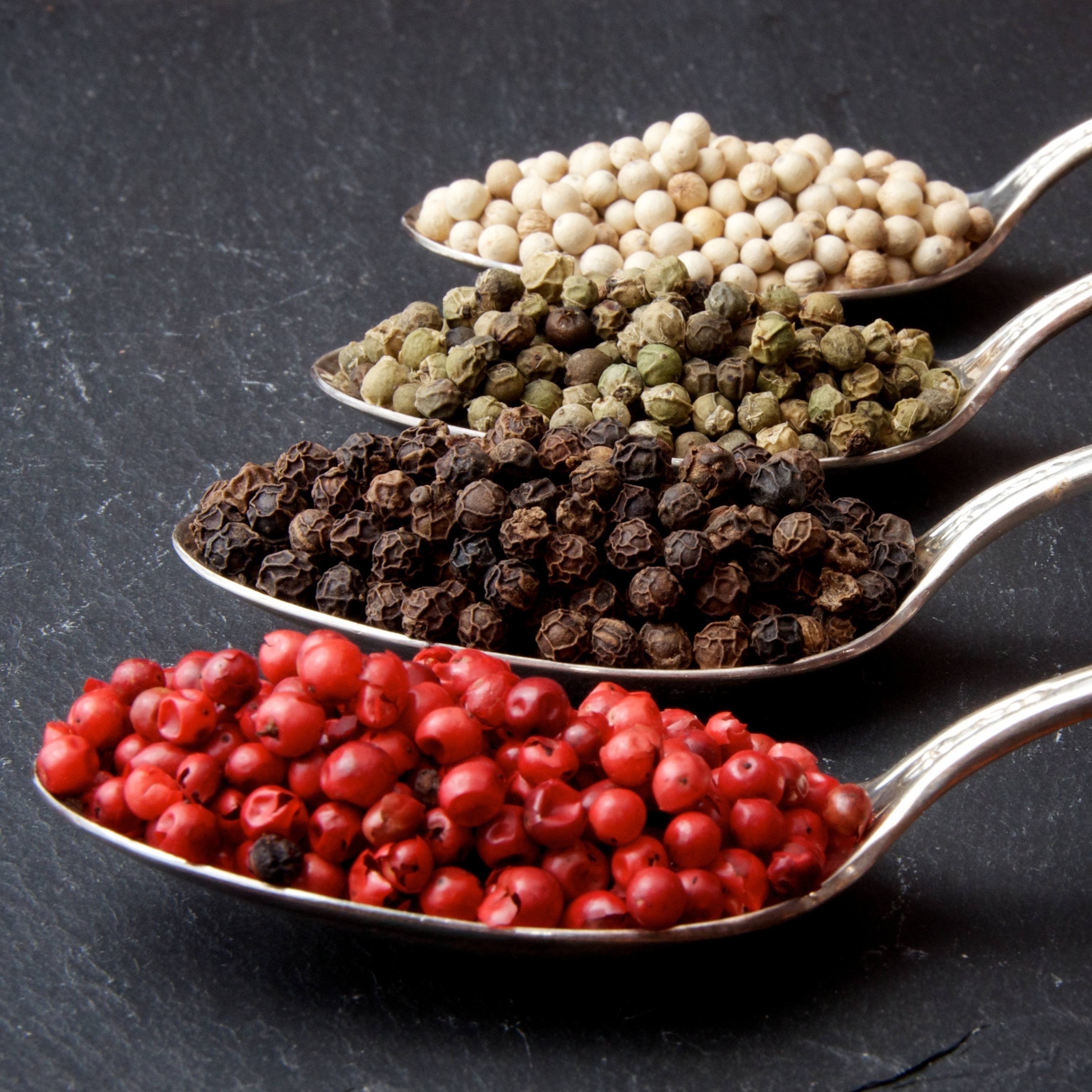
Peppers: Can You Take the Heat?
England’s Prince Charles, in his role as Duke of Cornwall, is entitled to an annual payment of feudal dues, the terms of which date to a charter of 1,230-signed just 15 years after King John was coerced into putting his royal stamp of approval on the Magna Carta.
Ever since, the Duke, traditionally the eldest son of the reigning monarch, has been entitled to a yearly gift of a hunting bow, a pair of gilt spurs, two greyhounds, a load of firewood, and a pound of peppercorns.
This last was no shabby present. Pepper, for much of European history, was literally worth its weight in gold. Rome bought off both the Visigoths and Attila the Hun with pepper; rents and dowries were paid in pepper; judges were bribed with pepper. A medieval serf who managed to scrape together a pound of pepper could use it to buy his or her freedom.
The pepper that Europeans so valued was black pepper, the tongue-tingling fruit of Piper nigrum, a climbing vine native to southern India. In the 15th century, following the fall of Constantinople to the Ottoman Turks, trade routes to India and the Far East were disrupted, and the price of pepper skyrocketed. The appalling cost of pepper played no small part in the decision of Ferdinand and Isabella to fund Columbus’s dicey voyage to the west.

Peppers and the New World
On January 15, 1493, Columbus made a note in his log about New World pepper: “There is also much aji which is their pepper and is worth more than our pepper, no one eats without it because it is very wholesome.” Dozens of varieties of peppers were grown by the natives of Central and South America. The Franciscan friar Bernardino de Sahagún, author of the General History of the Things of New Spain (1569), who spent more than 60 years in Aztec Mexico, made a stab at describing the extent of native pepper cuisine: it included, he wrote, “hot green chiles, smoked chiles, water chiles, tree chiles, beetle chiles, and sharp-pointed red chiles,” variously served up in such dishes as frog with green pepper, newt with yellow pepper, tadpoles with small peppers, grubs in pepper sauce, and lobster with red peppers, tomatoes, and ground squash seeds.
The New World peppers-unlike such suspicious foodstuffs as chocolate and tomatoes-were rapidly adopted by the Old. The Portuguese brought peppers to India in the early 16th century, where they became a prime component of curry; from there, they traveled farther east. Within 50 years of Columbus’s pepper-discovering voyage, American peppers were thriving in China and Japan.
New World peppers, despite Columbus’s deceptive name, have nothing to do with the Old World’s Piper nigrum. They are members of the Solanaceae or Nightshade family—relatives of tomatoes, potatoes, and eggplants—and belong, more specifically, to the genus Capsicum, a collection of some 25 species, five of which are cultivated by human gardeners. The name capsicum (used by the scientifically precise when talking about New World peppers) was coined in 1700 by French botanist Joseph Pitton de Tournefort, possibly from the Latin capsa (“box”), loosely based on the shape of the fruit, or from the Greek kapto (‘to bite”) from the effect of pepper on the human tongue.
Not all New World peppers are hot, but many are, and some are positively explosive. The pungency in black pepper is due to a spicy alkaloid called piperine; the zip, burn, or blazing scorch in New World peppers (often called chilies, from chilli, the Aztec word for pepper) is due to a chemical compound called capsaicin and assorted related capsaicinoids.
Capsaicin is mean stuff. In the form of pepper spray, joggers use it to fend off muggers, mail carriers use it to fend off dogs, and hikers use it to ward off bears. Ranchers smear it on sheep to discourage wolves; and gardeners use it to foil rabbits, deer, and squirrels. The Aztecs, in lieu of spanking, disciplined naughty children by holding them over piles of burning peppers.
Capsaicin: Torturing Your Tongue
Hotness in peppers is now analyzed using high-performance liquid chromatography (HPLC), but the time-honored technique-first devised in 1912-called for human tasters and the Scoville Organoleptic Test. The test, devised by Wilbur Scoville of the Parke-Davis pharmaceutical company, involved soaking pepper samples in alcohol to leach out the capsaicin, then diluting the extracts in a sucrose solution to generate a series of “cordials.” Tasters, cautiously sipping, identify the weakest solution in which the hotness sensation is detectable. The more the extract had to be diluted before the hotness sensation disappeared, the hotter the pepper.
Pepper hotness is still routinely expressed in Scoville Heat Units (SHU). On the Scoville scale, rock-bottom is the bell pepper, which isn’t hot at all, and rates an SHU score of 0. The relatively peaceful poblano ranges from 500-2000 SHU; the feisty jalapeño, 2500-8000; and the mouth-blitzing habañero, 300,000-575,000. (There’s a range because capsaicin content varies with the environment; hotter temperatures, for example, make for hotter peppers.)
Peppers with Scoville scores above 500,000 are designated superhot—though in some cases, a better descriptor might be “apocalyptic.” The best-known of these mega-peppers may be the bhut jolokia or ghost pepper, a hybrid developed in India, the first pepper to top a million SHU. As of 2007, the bhut jolokia ruled the roost as world’s hottest pepper according to Guinness World Records. Eaters compared it to taking a bite of molten lava.
Since then creative breeders have come up with peppers that are increasingly hotter yet, among them the intimidating Naga Viper, topping out at 1,349.000 SHU, the appalling Trinidad Moruga Scorpion (2,009,231 SHU), and the horrific current champion, the Carolina Reaper (2,200,000 SHU). (Pure capsaicin rates 16 million SHU.)
The sensation of heat (or, in some cases, downright conflagration) that comes with eating a hot pepper results from a protein called the TRPV1 receptor, found on the surface of sensory cells. TRPV1 functions to keep us from getting scalded. Ordinarily it’s activated by temperatures above 109 degrees F, warning us when things are too hot to handle. Capsaicin, however, tricks TRPV1 into turning on at body temperature. In other words, capsaicin makes your brain think you’re being burned, even though you’re not. It just feels like it.
No Pain, No Gain
So what possesses us to subject ourselves to these organic incendiary bombs?
One theory holds that hot peppers make us feel good. When capsaicin activates heat and pain receptors in the mouth, this in turn triggers the release of endorphins-endogenous morphine-like substances that reduce stress and induce euphoria. It just may be that hot-pepper-eating gives even couch potatoes the equivalent of a runner’s high.
Alternatively, according to psychologist Paul Rozin of the University of Pennsylvania, our passion for hot peppers may be an example of “constrained risk”: that is, we like them for the same reason that we’re attracted to scary movies, bungee-jumping, and roller coaster rides. All give us an adrenalin-laced thrill of danger without actually doing anything dangerous.
In any case, hot-pepper-eating seems to be a passion that’s peculiar only to us. “Man,” points out psychologist Paul Bloom, “is the only animal that likes Tabasco sauce.”
References
- Andrews, Jean. Peppers: The Domesticated Capsicums. University of Texas Press, 1984.
- DeWitt, Dave, and Paul W. Bosland. The Complete Chile Pepper Book. Timber Press, 2014.
- An organic solution to garden pests: see this site for instructions for making hot-pepper spray.








